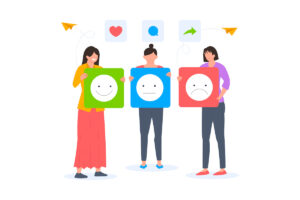We might cloud our customer exchanges with digitization and automation, but on the receiving end of every authentic interaction, is a human with their own complex set of interests and emotions.
It still takes gut-feeling marketing to create a meaningful relationship with customers and creating relevance is about tapping into a lexicon of emotion.
Finding the ‘why’ behind customer purchasing habits and behaviors enables you to curate a much better user experience, customer experience, and human experience…yep, that’s a lot of experience.
Connecting with customers on an emotional level builds relevance – they want meaning, privacy, comfort, ease, and control. If you can build an excellent experience around these human experiences then you can create and maintain relevance in people’s lives.
Build on Emotion
Creating an emotional experience for a brand and customer is integral to human relevance. Emotions are our most relevant social currency. According to Forrester, emotion is the main driver of customer experience.
A negative experience can have a very profound effect on a customer – this usually happens because of a mismatch in expectations. Customers aren’t receiving what they envisaged, so they feel cheated, let down and disappointed. A disrespected customer is incredibly difficult to win back and it all boils down to the emotion they’re holding.
Sometimes this is because brands run before they can walk. Instead of satisfying customers and providing them with ‘what they’ve been promised’ – they’re going too far and trying to make customers feel part of something bigger. The Disney style of customer service doesn’t work for every industry or brand. Sometimes it just isn’t relevant.
[Tweet “Creating relevance is about tapping into a lexicon of emotion. via @bryankramer”]
Focus on winning battles and providing excellent customer service with what’s expected of you first from customers. Nail down the foundational elements of your brand offering before you think bigger.
Having a personal experience with a brand can tap into customer emotion and a positive interaction can create a loyal customer. Most customers want to be valued as individuals which means providing individualized support, but it also means delivering reward and loyalty schemes that are tailored to an individual too – and relevant!
What’s relevant?
To truly cut through the clutter and find what makes your customers tick; you can create data-driven buyer personas. This will help you to generate more ideas about what’s relevant to your audience and segment your users.
One of the best, but often most neglected, ways to access data about customer needs and concerns is to pool info from your customer support teams. These are the team members on the frontline who are dealing with customers day in and day out – their interactions are gold dust, so use them!
Find out what kind of questions prospective customers are asking before they make purchasing decisions so you can provide relevant information to help them take action. Affiliate these questions with other data about your users, so you can try and create patterns and trends.
[Tweet “Human relevance is tied to emotion and the connection between a brand and customer via @bryankramer”]
What are your existing customers asking? Are you meeting their needs and providing relevance? Customers will be asking specific questions that are directly tied to their buying experience, so take note and flesh out buyer personas. You can help to anticipate pain points before they happen with how-to guides and FAQs.
The more data and information you gather about your prospective and existing customers, the more relevant you can make your brand’s customer experiences. So relevant in the fact that they’ll find the answers to their questions before they’ve asked them and find the resources to help them get the best out of a product or service.
Providing Value
Customer value is anchored to relevance. If you can provide timely and valuable content that gives solutions to customers, your brand will boost its human relevance.
Building your content strategy around value is important. At its core, the value is about bringing personal benefit to a customer’s lifestyle. Is your product or service better than the alternatives – is it more relevant to their specific set of circumstances?
People will buy from your brand because they like or need a product. But proving value can grow throughout a customer journey and it’s your job to insert value-growth into your processes. Value is so subjective that you’ll never be in control of it, but you can influence and encourage value growth.
Customer research, focus groups, surveys, and interviews are all great ways to dig deeper with your customers and find out what matters to them, what keeps them awake at night and what they’re looking for.
And as a brand, you need to think about whether you have the right team and skillsets to provide value to customers.
HubSpot came up with the DARC model and it’s a pretty good roadmap for the type of employees that will understand customers and help to curate relevancy:
- D – Digital citizens are people that have grown up online. They understand the inner workings of the dynamic digital landscape and can use specific language, gifs, memes etc to improve relevancy.
- A – Analytics is super important and hiring team members that can identify future trends, what’s relevant and what customers are talking about is a good start.
- R – Web Reach can be demonstrated by staff that has grown their own passion projects, whether that’s a blog or a Twitter account. They know how to make an impact.
- C – Content Creators with skill allow you to stand out from competitors. They know how to write in a way that’s current, relevant and engages customers.
Human relevance is tied to emotion and the connection between a brand and customer. If customers feel like you ‘get them’ and understand their needs and concerns, you’re strengthening the relevancy of your brand.
When you create products and services that are relevant to a customer’s lifestyle, it makes it easier for them to make a purchasing decision. You can do this by building a customer journey based on emotion, learning more about your customers and providing value.





